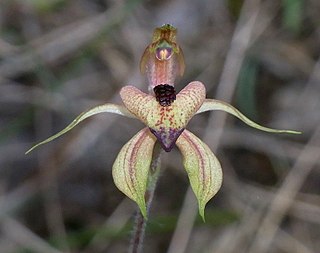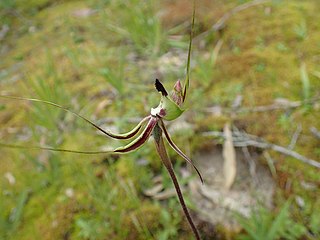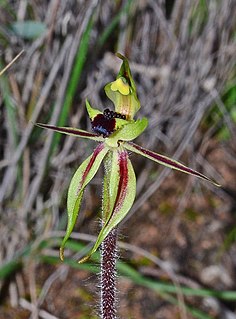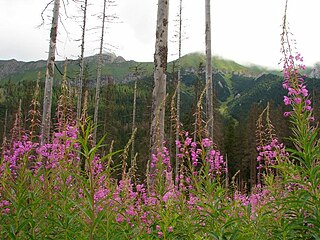
Caladenia dilatata, commonly known as the green-comb spider orchid and as koolin in indigenous language, is a plant in the orchid family Orchidaceae and is endemic to south-eastern Australia. It has a single leaf and a single yellowish-green flower with reddish stripes and occurs in Victoria and Tasmania. It is similar to C. necrophylla which occurs in south-east South Australia and to C. concinna from southern New South Wales.

Caladenia cardiochila, commonly known as thick-lipped spider-orchid, fleshy-lipped caladenia and heartlip spider-orchid, is a plant in the orchid family Orchidaceae and is endemic to Victoria and South Australia. It is a ground orchid with a single hairy leaf and one or two yellowish-green, red-striped flowers on a thin, wiry stem.

Caladenia clavigera, commonly known as plain-lip spider orchid or clubbed spider orchid is a plant in the orchid family Orchidaceae and is endemic to Australia. It is a ground orchid which grows as scattered individuals or in small colonies in Victoria, New South Wales and South Australia. It has a single leaf and one or two small yellowish-green and red flowers.
Caladenia conferta, commonly known as the crowded spider orchid or coast spider-orchid, is a plant in the orchid family Orchidaceae and is endemic to a restricted area in South Australia. It is a ground orchid with a single hairy leaf, and usually a single yellowish-green flower with red markings on a wiry, hairy stalk.

Caladenia exstans, commonly known as the pointing spider orchid, is a species of orchid endemic to a small area in the south-west of Western Australia. It has a single, hairy leaf and one or two green, yellow and red flowers with a labellum which does not curl downwards but "points" forward.

Caladenia fragrantissima, commonly known as the scented spider orchid, is a plant in the orchid family Orchidaceae and is endemic to Victoria and South Australia. It is a ground orchid with a single hairy leaf and up to three creamy-white to yellowish-green flowers. It is possible that it is conspecific with Caladenia orientalis.

Caladenia georgei, commonly known as the tuart spider orchid, is a species of orchid endemic to the south-west of Western Australia. It has a single, hairy leaf and up to three whitish to yellowish-green flowers flushed with red and which have a white labellum with a red tip.

Caladenia gladiolata, commonly known as small bayonet spider orchid, smelly socks or simply bayonet orchid is a plant in the orchid family Orchidaceae and is endemic to South Australia. It is a ground orchid with a single hairy leaf and one or two yellowish or brownish flowers with red stripes and unusual tips on the sepals and petals.
Caladenia graniticola, commonly known as the Pingaring spider orchid, is a species of orchid endemic to the south-west of Western Australia. It has a single, hairy leaf and one or two yellowish-green, red and white flowers which have a greenish-yellow and white labellum with a red tip. It was originally described as Caladenia hoffmanii subsp. graniticola but has a slightly different labellum and column.
Caladenia granitora, commonly known as the granite spider orchid, is a species of orchid endemic to the south-west of Western Australia. It has a single, hairy leaf and one or two yellowish-cream, white and red flowers which have a white labellum with a red tip.
Caladenia macroclavia, commonly known as the large-club spider orchid, or brown bayonets, is a plant in the orchid family Orchidaceae and is endemic to South Australia. It is a ground orchid with a single hairy leaf and a single green to yellowish-green flower with dark red central stripes. It is a rare species and in 2006 the total population was estimated to be between 35 and 80 mature plants.

Caladenia phaeoclavia, commonly known as the brown-clubbed spider orchid is a species of orchid endemic to New South Wales. It has a single, hairy leaf and a single light to dark green flower with red stripes and thick, brownish club-like tips on the sepals.

Caladenia reticulata, commonly known as the veined spider orchid, is a plant in the orchid family Orchidaceae and is endemic to Victoria and South Australia. It is a ground orchid with a single, hairy leaf and usually only one yellowish-green and red flower.
Caladenia richardsiorum, commonly known as the little dip spider orchid, Richards' spider orchid or robe spider orchid, is a plant in the orchid family Orchidaceae and is endemic to South Australia. It is a ground orchid with a single erect, hairy leaf and usually only one yellowish-green flower. It is similar to the endangered Mellblom's spider orchid but has a much larger leaf and the petals lack glandular tips.

Caladenia septuosa, commonly known as the Koppio spider orchid, is a plant in the orchid family Orchidaceae and is endemic to South Australia. It is a ground orchid with a single erect, sparsely hairy leaf and usually only one greenish-cream flower with red stripes along the sepals and petals.

Caladenia tessellata, commonly known as the thick-lip spider-orchid, is a plant in the orchid family Orchidaceae and is endemic to south-eastern Australia. It is a ground orchid with a single hairy leaf and one or two yellowish-green flowers with dark red markings.

Caladenia stricta, commonly known as the upright spider orchid or rigid-combed spider-orchid is a plant in the orchid family Orchidaceae and is endemic to southern continental Australia. It is a ground orchid with a single leaf and usually only one pale green flower with red lines along the sepals and petals.

Caladenia toxochila, commonly known as the bow-lip spider orchid is a plant in the orchid family Orchidaceae and is endemic to south-eastern Australia. It is a ground orchid with a single, sparsely hairy leaf and one or two yellowish-green flowers with red stripes. It occurs in Victoria and South Australia and resembles the related Caladenia concinna from New South Wales.
Caladenia rileyi, commonly known as the Gillenbah spider orchid, is a plant in the orchid family Orchidaceae and is endemic to New South Wales. It is a ground orchid with a single leaf and a single yellowish-green and red flower.
Caladenia sanguinea, commonly known as red spider orchid or crimson daddy long-legs, is a species of orchid endemic to South Australia. It has a single sparsely hairy leaf and one or two dark red flowers with long, thin sepals and petals.





















